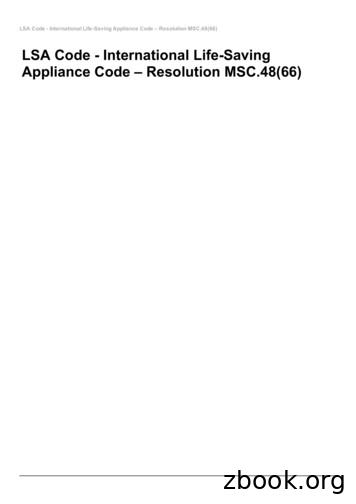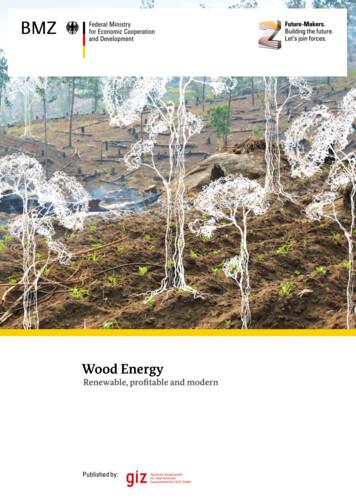Life Saving Rules - Wood
0Life Saving RulesOur Life Saving Rules are an important part of our SafetyShield and it is up to everyone in Wood to know them,understand them and above all follow them.Compliance with the Life Saving Rules are a condition of employment within Woodand must be followed at all times. They must also be complied with by Wood’scontractors, subcontractors and relevant third party vendors and Wood personnelinvolved in joint venture projects.
Bypassing Safety ControlsObtain authorisation before overridingor disabling safety controls. I understand and use safety critical equipment and procedureswhich apply to my task I obtain authorisation before:-- disabling or overriding safety equipment-- deviating from procedure-- crossing a barrier
Confined SpaceObtain authorisation before entering a confined space. I confirm energy sources are isolated I confirm the atmosphere has been tested and is monitored I check and use my breathing apparatus when required I confirm there is an attendant standing by I confirm a rescue plan is in place I obtain authorisation to enter
DrivingFollow safe driving rules. I always wear a seatbelt I do not exceed the speed limit, and reduce my speed for road conditions I do not use phones or operate devices while driving I am fit, rested and fully alert while driving I follow journey management requirements
0Energy IsolationVerify isolation and zero energy before work begins. I have identified all energy sources I confirm that hazardous energy sources have beenisolated, locked and tagged I have checked there is zero energy and tested forresidual or stored energy
Hot WorkControl flammables and ignition sources. I identify and control ignition sources Before starting any hot work:-- I confirm flammable materials has been removed or isolated-- I obtain authorisation Before starting any hot work in a hazardous area, I confirm:-- A gas test has been completed-- Gas will be monitored continually
Line of FireKeep yourself and others out of the line of fire. I position myself to avoid:-- moving objects-- vehicles-- pressure releases-- dropped objects I establish and obey barriers and exclusion zones I take action to secure loose objects and report potential dropped objects
Safe Mechanical LiftingPlan lifting operations and control the area. I confirm that the equipment and load have beeninspected and are fit for purpose I only operate equipment that I am qualified to use I establish and obey barriers and exclusion zones I never walk under a suspended load
Work AuthorisationWork with a valid permit when required. I have confirmed if a permit is required I am authorised to perform the work I understand the permit I have confirmed that hazards are controlled, and it is safe to start I stop and reassess if conditions change
Working at HeightProtect yourself against a fall when working at height. I inspect my fall protection equipment before use I secure tools and work materials to prevent dropped objects I tie off 100% to approved anchor points while outside a protected area
Life Saving Rules Our Life Saving Rules are an important part of our Safety Shield and it is up to everyone in Wood to know them, understand them and above all follow them. 0 Compliance with the Life Saving Rules are a condition of employment within Wood and must be followed at all times. They must also be complied with by Wood’s
3.3 The Life-Saving Rules as part of a system 12 3.4 Life-Saving Rules implementation resources 19 4. Data analysis in the revision of the Life-Saving Rules 20 Contents 4 I Life-Saving Rules. Scope With the revision of Report 459, IOGP launches a simpli
Life Saving Rules which are recognized and enforced by companies. These Life Saving Rules are intended to supplement and/or support existing company management systems, programs and policies. These Life Saving Rules are based upon the International Association of Oil and Gas Producers (IOGP) Life Saving Rules to maximize industry alignment.
LSA Code International Life Saving Appliance Code – Resolution MSC.48(66) Chapter I General 1.1 Definitions 1.1 Definitions 1.1.1. Convention means the International Convention for the Safety of Life at Sea, 1974, as amended. 1.1.2. Effective clearing of the ship is File Size: 729KBPage Count: 50Explore furtherLife-Saving Appliances inc. LSA Code, 2017 Edition .fontanski.plInternational Life-saving Appliance (LSA) Codeindustrialgraphicsupply.com(PDF) LSA CODE INTERNATIONAL LIFE-SAVING APPLIANCE CODE .www.academia.eduLife-Saving Appliance LSA Code, 2017 Edition IMO Bookswww.amnautical.comLSA-Code International Life-saving appliance Code (MSC.48 .puc.overheid.nlRecommended to you b
3 Key Advantages of Wood-based Fuels 1.1 Wood energy is widely used and renewable 1.2 Sustainable wood production safeguards forest functions 1.3 Wood energy is available locally 1.4 Wood energy provides employment and income 1.5 Wood energy supports domestic economies 1.6 Wood energy is modern and leads to innovation 1.7 Wood energy can make a country independent of energy imports
wood (see Section "Role of wood moisture content on corrosion"). 3. Wood preservatives Wood preservatives are chemicals that are injected into the wood to help the wood resist attack by decay fungi, mold, and/or termites. Waterborne wood preservatives are commonly used when the wood may be in contact with humans or will be painted.
Rules database is the basis of the rules engine and it is a collection of rules files which are established by rules engine. Rules database is maintained by rules management and it is used by rules engine. (5) Rules Matching The first step is modelling with rules files in rules database. Then, it will match rules with users'
Consistent application of the Life Saving Rules equates to saved lives These rules are essential to achieving industry’s shared vision: zero injuries, zero incidents SUMMARY LIFE SAVING RULES - FIT FOR DUTY 10
the ISO 14001 standard and provide step-by-step procedures, sample documents or templates, and tips for developing and implementing an EMS that is appropriate to the organization and its operations. Please remember that this is a guidance document and not a rigid instruction manual. All of the ISO elements must be addressed in your program and meet the ISO requirements, but you will notice .























